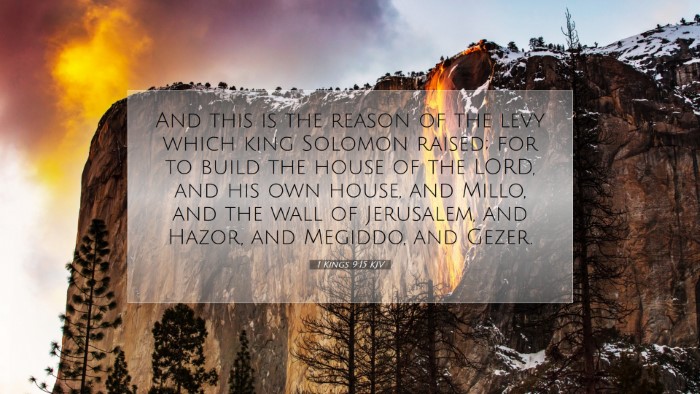Commentary on 1 Kings 9:15
Verse (1 Kings 9:15): “And this is the reason of the levy which king Solomon raised, for to build the house of the Lord, and his own house, and Millo, and the wall of Jerusalem.”
Introduction
The verse in question provides a crucial insight into the administrative and economic efforts of King Solomon during his reign. This commentary synthesizes the interpretations from various public domain sources to give a profound understanding of this text, particularly its implications for Biblical leadership and the construction of sacred spaces.
Historical Context
This verse appears in a pivotal chapter concerning Solomon’s achievements and the necessary preparations he made to establish a lasting legacy, particularly through the construction of the Temple. The context involves Solomon’s vast endeavors to fortify and beautify the city of Jerusalem while also ensuring the worship of Yahweh was prioritized.
Insights from Commentators
Matthew Henry's Commentary
Henry emphasizes the significance of the “levy” Solomon imposed. He notes that this taxation was not merely for any idle purpose; rather, it was directed towards substantial undertakings—both religious and civil. Henry points out that the construction of the Temple represents a divine mandate and reflects the heart of Solomon's devotion to God.
- Divine Purpose: Henry argues that God’s house must be built and outfitted according to the glory of God, reflecting obedience to divine instruction.
- Solomon's Legacy: The construction of Millo (a fortified structure) and city walls underlines the importance of security and strength for future generations.
Albert Barnes' Notes on the Bible
Barnes highlights the practical implications of Solomon's financial and political moves. He describes how this levy was established not just as a burden on the people, but as a necessary sacrifice for the greatness of the nation. He comments on the importance of solidifying borders and enhancing the city’s defenses, interpreting this as part of fulfilling God’s promises to Israel.
- Taxation Analysis: Barnes notes how Solomon's levy can be understood as wise stewardship rather than exploitation, ensuring that the nation is prepared for divine blessing.
- Unity of Purpose: The simultaneous building of the Temple and fortifications illustrates the dual necessity for spiritual and physical security, calling leaders today to balance these priorities in their ministries.
Adam Clarke's Commentary
Clarke offers a more intricate look at the logistics of Solomon’s projects. He comments on the extensive resources and diverse labor necessary to complete such a monumental task. Clarke’s analysis includes observations on the socio-economic systems in place that allowed for such projects to be realized.
- Workforce Dynamics: Clarke discusses the import of skilled workers and priests who contributed to the Temple’s artistry, which can be used as a metaphor today for church staff and volunteers who work towards enhancing the worship experience.
- King's Accountability: Clarke emphasizes Solomon’s duty to his people—suggesting that leaders must always act with accountability to ensure the welfare of those they serve.
Theological Implications
This verse, while discussing historical constructs, holds profound theological significance for modern readers. The project to build the Temple serves as a vivid reminder of God's presence among His people and the importance of dedicating resources, time, and effort towards worship and service. It elucidates that the work done for God is not merely physical construction but a spiritual endeavor which requires the fullness of one’s being.
Lessons for Leaders
From the analyses provided by these commentators, several key lessons emerge for contemporary Christian leaders:
- Visionary Leadership: Like Solomon, leaders must pursue visions that serve their communities spiritually and practically.
- Shared Sacrifice: Emphasizing collective investment creates a sense of ownership and communal responsibility.
- Balanced Focus: It is essential to integrate spiritual goals with practical actions, bridging the gap between faith and works effectively.
Conclusion
In conclusion, 1 Kings 9:15 unlocks a wealth of wisdom about the interplay between faith, governance, and community investment. Solomon’s actions—driven by his religious convictions and responsibilities towards his people—serve as an enduring example for leaders across generations. This passage compels us to consider how our efforts in building a community of faith not only strengthen our churches but also encompass service, guardian roles, and a dedication to the divine mission entrusted to us.


